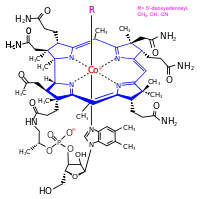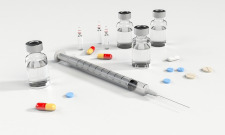Contents:
Water soluble vitamins:
- Vitamin B1 (thiamine)
- Vitamin B2 (riboflavin)
- Vitamin B3 (niacin)
- Vitamin B5 (pantothenic acid)
- Vitamin B6 (pyridoxine)
- Vitamin B7 (biotin)
- Vitamin B9 (folic acid)
- Vitamin B12 (cobalamin)
- Vitamin C (ascorbic acid)
Fat soluble vitamins:
Different types of vitamins responsible for overall health as they perform a variety of functions in the human body.
All food sources have some amount of vitamins in them. A shortage of vitamins in a diet can cause different types of ailments.
For better planning of vitamin intakes established different types of reference values such as recommended dietary allowance, adequate intake, and tolerable upper intake level.
Water soluble vitamins
 Thiamin pyrophosphate (TPP), the active form of thiamin, is involved in several enzyme functions associated with the metabolism of carbohydrates, branched-chain amino acids, and fatty acids.
Thiamin pyrophosphate (TPP), the active form of thiamin, is involved in several enzyme functions associated with the metabolism of carbohydrates, branched-chain amino acids, and fatty acids.
The synthesis of thiamin pyrophosphate from free thiamin requires magnesium, adenosine triphosphate (ATP), and the enzyme, thiamin pyrophosphokinase.
Thiamin pyrophosphate is required as a coenzyme for four multi-component enzyme complexes.
Signs and symptoms of thiamine deficiency
Severe thiamin deficiency leads to beriberi, a disease that affects multiple organ systems, including the central and peripheral nervous systems.
Thiamin deficiency affects the cardiovascular, nervous, muscular, gastrointestinal, and central and peripheral nervous systems.
The Recommended Dietary Allowance (RDA)
The RDA for adults is 1.2 mg/day for men and 1.1 mg/day for women.
Optimal Intake - 5-15 mg.
Food sources of thiamine
Most nutritious foods have some thiamin.
Some foods naturally rich in thiamine are oatmeal, flax, and sunflower seeds, brown rice, whole grain rye, asparagus, kale, cauliflower, potatoes, oranges, liver (beef, pork, and chicken), and eggs.
Thiamine safety
The Food and Nutrition Board did not set a tolerable upper intake level (UL) for thiamin because there are no well-established toxic effects from consumption of excess thiamin in food or through long-term, oral supplementation (up to 200 mg/day).
 Riboflavin is the precursor of the coenzymes, flavin adenine dinucleotide (FAD) and flavin mononucleotide (FMN). They act as electron carriers in a number of oxidation-reduction(redox) reactions involved in energy production and in numerous metabolic pathways.
Riboflavin is the precursor of the coenzymes, flavin adenine dinucleotide (FAD) and flavin mononucleotide (FMN). They act as electron carriers in a number of oxidation-reduction(redox) reactions involved in energy production and in numerous metabolic pathways.
Living organisms derive most of their energy from redox reactions, which are processes that involve the transfer of electrons.
Flavocoenzymes participate in redox reactions in numerous metabolic pathways. They are critical for the metabolism of carbohydrates, lipids, and proteins.
Flavin mononucleotide is part of the electron transport (respiratory) chain, which is central to energy production.
In conjunction with cytochrome P-450, flavocoenzymes also participate in the metabolism of drugs and toxins.
Signs and symptoms of riboflavin deficiency
Riboflavin deficiency can affect multiple pathways in the metabolism of vitamin B6, folate, niacin, and iron.
Riboflavin deficiency (also called ariboflavinosis) results in stomatitis including painful red tongue with sore throat, chapped and fissured lips (cheilosis), and inflammation of the corners of the mouth.
The Recommended Dietary Allowance (RDA)
The RDA for adults is 1.3 mg/day for men and 1.1 mg/day for women.
Epidemiological studies of cataract prevalence indicate that riboflavin intakes of 1.6 to 2.2 mg/day may reduce the risk of developing age-related cataracts.
Additionally, older people suffering from acute ischemic stroke were found to be deficient for riboflavin, and riboflavin deficiency has been linked to a higher risk of fracture in postmenopausal women with the MTHFR 677T variant.
Individuals whose diets may not supply adequate riboflavin, especially those over 50 years of age, should consider taking a multivitamin/mineral supplement, which generally provides at least 1.7 mg/day of riboflavin.
Optimal Intake - 5-20 mg.
Food sources of riboflavin
Sources of riboflavin are milk, cheese, leaf vegetables, liver, kidneys, legumes, yeast, mushrooms, and almonds.
Riboflavin safety
No toxic or adverse effects of high riboflavin intake in humans are known.
 Niacin and its derivative nicotinamide are dietary precursors of nicotinamide adenine dinucleotide (NAD), which can be phosphorylated (NADP) and reduced (NADH and NADPH).
Niacin and its derivative nicotinamide are dietary precursors of nicotinamide adenine dinucleotide (NAD), which can be phosphorylated (NADP) and reduced (NADH and NADPH).
Nicotinamide adenine dinucleotide functions in oxidation-reduction (redox) reactions and non-redox reactions.
Over 400 enzymes require the niacin coenzymes, NAD and NADP, mainly to accept or donate electrons for redox reactions.
Nicotinamide adenine dinucleotide functions most often in energy-producing reactions involving the degradation (catabolism) of carbohydrates, fats, proteins, and alcohol.
Nicotinamide adenine dinucleotide phosphate (NADP) functions more often in biosynthetic (anabolic) reactions, such as in the synthesis of all macromolecules, including fatty acids and cholesterol.
Signs and symptoms of B3 deficiency
The most common symptoms of niacin deficiency involve the skin, the digestive system, and the nervous system.
Pellagra is the disease of severe niacin deficiency. It is characterized by symptoms affecting the skin, the digestive system, and the nervous system and can lead to death if left untreated.
The Recommended Dietary Allowance (RDA)
The RDA for adults is 16 mg/day for men and 14 mg/day for women.
Niacin food sources
Good sources of niacin include yeast, meat, poultry, red fish (e.g., tuna, salmon), cereals (especially fortified cereals), legumes, and seeds.
Milk, green leafy vegetables, coffee, and tea also provide some niacin.
Vitamin B3 safety
The tolerable upper intake level (UL) for niacin (35 mg/day) is based on skin flushing, niacin's most prominent side effect.
A new drug, laropiprant, has been developed to reduce skin flushing.
Niacin from foods is not known to cause adverse effects.
 Pantothenic acid – also known as vitamin B5 – is a water soluble vitamin that is a precursor in the synthesis of coenzyme A.
Pantothenic acid – also known as vitamin B5 – is a water soluble vitamin that is a precursor in the synthesis of coenzyme A.
Coenzyme A is essential to many biochemical reactions that sustain life.
Also, the phosphopantetheinyl moiety of coenzyme A is required for the biological activity of several proteins, including the acyl-carrier protein involved in fatty acid synthesis.
Signs and symptoms of pantothenic acid deficiency
Naturally occurring pantothenic acid deficiency in humans is very rare and has been observed only in cases of severe malnutrition.
The Adequate Intake (AI)
The Food and Nutrition Board of the US Institute of Medicine set an adequate intake (AI) of 5 milligrams (mg)/day for adults.
Optimal Intake - 15-500 mg.
Vitamin B5 food sources
Small quantities of pantothenic acid are found in most foods. The major food source of pantothenic acid is meat. Vegetables, such as avocados and broccoli, also have an abundance.
Vitamin B5 safety
Little or no toxicity has been associated with dietary and supplemental pantothenic acid such that no tolerable upper intake level (UL) has been set.
Vitamin B6 (pyridoxine, pyridoxal 5'-phosphate) function
 Vitamin B6 and its derivative pyridoxal 5'-phosphate (PLP) are essential to over 100 enzymes mostly involved in protein metabolism.
Vitamin B6 and its derivative pyridoxal 5'-phosphate (PLP) are essential to over 100 enzymes mostly involved in protein metabolism.
The term vitamin B6 refers to six common forms, namely pyridoxal, pyridoxine (pyridoxol), pyridoxamine, and their phosphorylated forms.
The phosphate ester derivative pyridoxal 5'-phosphate (PLP) is the bioactive coenzyme form involved in over 4 percent of all enzymatic reactions.
The many biochemical reactions catalyzed by PLP-dependent enzymes are involved in essential biological processes, such as hemoglobin and amino acid biosynthesis, as well as fatty acid metabolism.
Signs and symptoms of B6 deficiency
Severe deficiency of vitamin B6 is uncommon.
The Recommended Dietary Allowance (RDA)
Since vitamin B6 is involved in many aspects of metabolism, especially in amino acid metabolic pathways, an individual's protein intake is likely to influence the requirement for vitamin B6.
The RDA for adults is 1.7 mg/day for men and 1.5 mg/day for women.
Vitamin B6 food sources
Vitamin B6 is widely distributed in foods in both its free and bound forms.
Foods that contain large amounts of vitamin B6 include pork, turkey, beef, bananas, chickpeas, potatoes, and pistachios.
Vitamin B6 safety
Although vitamin B6 is a water soluble vitamin and is excreted in the urine, long-term supplementation with very high doses of pyridoxine may result in painful neurological symptoms known as sensory neuropathy.
To prevent sensory neuropathy in virtually all individuals, the Food and Nutrition Board of the Institute of Medicine set the tolerable upper intake level (UL) for pyridoxine at 100 mg/day for adults.
 Water soluble biotin is an essential cofactor to enzymes in intermediary metabolism and a key regulator of gene expression.
Water soluble biotin is an essential cofactor to enzymes in intermediary metabolism and a key regulator of gene expression.
Vitamin B7 helps convert food into energy and synthesize glucose. Helps make and break down some fatty acids.
Biotin functions as a coenzyme in bicarbonate-dependent carboxylation reactions.
Signs and symptoms of biotin deficiency
Signs of overt biotin deficiency include hair loss (alopecia) and a scaly red rash around the eyes, nose, mouth, and genital area.
Neurologic symptoms in adults have included depression, lethargy, hallucinations, numbness and tingling of the extremities, ataxia, and seizures.
The Adequate Intake (AI)
The recommended adequate intake (AI) of biotin is set at 30 micrograms (μg)/day in adults.
Dietary intakes of generally healthy adults have been estimated to be 40-60 μg/day of biotin.
Optimal Intake - 300-10,000 mcg.
Food sources of vitamin B7
Raw egg yolk, liver, peanuts, leafy green vegetables and yeast are rich sources of biotin.
Vitamin B7 safety
Biotin is not known to be toxic.
Vitamin B9 (folic acid) function
 Folate is a generic term referring to both natural folates in food and folic acid, the synthetic form used in supplements and fortified food.
Folate is a generic term referring to both natural folates in food and folic acid, the synthetic form used in supplements and fortified food.
Folate is critical in the metabolism of nucleic acid precursors and several amino acids, as well as in methylation reactions.
Signs and symptoms of folic acid deficiency
Severe deficiency in either folate or vitamin B12 can lead to megaloblastic anemia, which causes fatigue, weakness, and shortness of breath.
Rapidly dividing cells like those derived from bone marrow are most vulnerable to the effects of folate deficiency since DNA synthesis and cell division are dependent on folate coenzymes.
The Recommended Dietary Allowance (RDA)
Recommended Dietary Allowance for folate in Dietary Folate Equivalents (DFEs) is set at 400 micrograms (μg)/day in adults.
Optimal Intake- 400-1,000 mcg.
Vitamin B9 food sources
Folate naturally occurs in a wide variety of foods, including vegetables (particularly dark green leafy vegetables), fruits and fruit juices, nuts, beans, peas, dairy products, poultry and meat, eggs, seafood, grains, and some beers.
Avocado, spinach, liver, yeast, asparagus, and brussels sprouts are among the foods with the highest levels of folate.
Vitamin B9 safety
No adverse effects have been associated with the consumption of excess folate from food.
The Food and Nutrition Board of the US Institute of Medicine advises that all adults limit their intake of folic acid (supplements and fortification) to 1,000 μg (1 mg) daily.
Vitamin B12 (cobalamin) function
 Vitamin B12 or cobalamin plays essential roles in folate metabolism and in the synthesis of the citric acid cycle intermediate, succinyl-CoA.
Vitamin B12 or cobalamin plays essential roles in folate metabolism and in the synthesis of the citric acid cycle intermediate, succinyl-CoA.
Vitamin B12 and folate are important for homocysteine metabolism.
Vitamin B12 is essential for the preservation of the myelin sheath around neurons and for the synthesis of neurotransmitters.
Signs and symptoms of cobalamin deficiency
Vitamin B12 deficiency is commonly associated with chronic stomach inflammation, which may contribute to an autoimmune vitamin B12 malabsorption syndrome called pernicious anemia and to a food-bound vitamin B12 malabsorption syndrome.
Impairment of vitamin B12 absorption can cause megaloblastic anemia and neurologic disorders in deficient subjects.
The preservation of DNA integrity is dependent on folate and vitamin B12availability.
The Recommended Dietary Allowance (RDA)
The RDA for adults is 2.4 micrograms/day.
Optimal Intake - 100-1,000 mcg.
Vitamin B12 food sources
Vitamin B12 is present in animal products, such as meat, poultry, fish (including shellfish), and to a lesser extent dairy products and eggs.
Vitamin B12 safety
No toxic or adverse effects have been associated with large intakes of vitamin B12 from food or supplements in healthy people.
Vitamin C (ascorbic acid) function
 Vitamin C functions as an essential cofactor in numerous enzymatic reactions, e.g., in the biosynthesis of collagen, carnitine, and catecholamines, and as a potent antioxidant.
Vitamin C functions as an essential cofactor in numerous enzymatic reactions, e.g., in the biosynthesis of collagen, carnitine, and catecholamines, and as a potent antioxidant.
Even in small amounts vitamin C can protect indispensable molecules in the body, such as proteins, lipids (fats), carbohydrates, and nucleic acids (DNA andRNA), from damage by free radicals and reactive oxygen species (ROS) that are generated during normal metabolism, by active immune cells, and through exposure to toxins and pollutants (e.g., certain chemotherapy drugs and cigarette smoke).
Vitamin C also participates in redox recycling of other important antioxidants; for example, vitamin C is known to regenerate vitamin E from its oxidized form.
Signs and symptoms of ascorbic acid deficiency
Severe vitamin C deficiency has been known for many centuries as the potentially fatal disease, scurvy.
Symptoms of scurvy include subcutaneous bleeding, poor wound closure, and bruising easily, hair and tooth loss, and joint pain and swelling. Such symptoms appear to be related to the weakening of blood vessels, connective tissue, and bone, which all contain collagen.
Early symptoms of scurvy like fatigue may result from diminished levels of carnitine, which is needed to derive energy from fat, or from decreased synthesis of the catecholamine norepinephrine.
The Recommended Dietary Allowance (RDA)
The RDA for adults is 90 mg/day for men and 75 mg/day for women.
Optimal Intake - 250-1,000 mg.
Vitamin C food sources
The richest natural sources are fruits and vegetables.
Vitamin C safety
A tolerable upper intake level of 2 grams (2,000 milligrams) daily was recommended in order to prevent most adults from experiencing diarrhea and gastrointestinal disturbances.
Fat soluble vitamins
 Vitamin A is a generic term that encompasses a number of related compounds.
Vitamin A is a generic term that encompasses a number of related compounds.
Vitamin A is involved in regulating the growth and specialization (differentiation) of virtually all cells in the human body.
Vitamin A helps form and maintain healthy skin, teeth, skeletal and soft tissue, mucus membranes, and skin.
It is also known as retinol because it produces the pigments in the retina of the eye.
Signs and symptoms of retinol deficiency
Due to the unique function of retinal as a visual chromophore, one of the earliest and specific manifestations of vitamin A deficiency is impaired vision, particularly in reduced light – night blindness.
Persistent deficiency gives rise to a series of changes, the most devastating of which occur in the eyes. Some other ocular changes are referred to as xerophthalmia. First, there is dryness of the conjunctiva (xerosis) as the normal lacrimal and mucus-secreting epithelium is replaced by a keratinized epithelium. This is followed by the build-up of keratin debris in small opaque plaques (Bitot's spots) and, eventually, erosion of the roughened corneal surface with softening and destruction of the cornea (keratomalacia) and leading to total blindness.
Other changes include impaired immunity (increased risk of ear infections, urinary tract infections, Meningococcal disease), hyperkeratosis (white lumps at hair follicles), keratosis pilaris and squamous metaplasia of the epithelium lining the upper respiratory passages and urinary bladder to a keratinized epithelium.
With relations to dentistry, a deficiency in Vitamin A leads to enamel hypoplasia.
The Recommended Dietary Allowance (RDA)
The recommended dietary allowance (RDA) is 700 micrograms of retinol activity equivalents (μg RAE)/day for women and 900 μg RAE/day for men.
Vitamin A food sources
Animal food sources rich in preformed vitamin A include dairy products, fortified cereal, liver, and fish oils.
Rich sources of provitamin A carotenoids include orange and green vegetables, such as sweet potato and spinach.
Vitamin A safety
The tolerable upper intake level (UL) for vitamin A in adults is set at 3,000 μg RAE/day.
The UL does not apply to vitamin A derived from carotenoids.
Vitamin D refers to a group of fat soluble secosteroids responsible for enhancing intestinal absorption of calcium, iron, magnesium, phosphate, andzinc.
In humans, the most important compounds in this group are vitamin D3 (also known as cholecalciferol) and vitamin D2 (ergocalciferol).
Vitamin D is essential for maintenance of bone mineralization through the regulation of calcium and phosphorus homeostasis.
Vitamin D also exhibits many non-skeletal effects, particularly on the immune, endocrine, and cardiovascular systems.
Vitamin D can regulate cell differentiation and growth by binding to the vitamin D receptor found in most body cells.
Signs and symptoms of vitamin D deficiency
Vitamin D is important for normal bone development and maintenance.
Severe vitamin D deficiency causes rickets in children and osteomalacia in adults.
The Recommended Dietary Allowance (RDA)
The RDA for adults is 15 mg/day (800 IU/day) for men and women.
Vitamin D food sources
Vitamin D is found naturally in only a few foods, such as some fatty fish (mackerel, salmon, sardines), fish liver oils, and eggs from hens that have been fed vitamin D.
Vitamin D safety
Vitamin D toxicity (hypervitaminosis D) has not been observed to result from sun exposure.
Tolerable Upper Intake Level (UL) for vitamin D in adults is set at 100 μg/day (4,000 IU/day).
Vitamin E (α-tocopherol) function
 Naturally occurring vitamin E includes eight fat soluble isoforms: α-, β-, γ-, and δ-tocopherol and α-, β-, γ-, and δ-tocotrienol.
Naturally occurring vitamin E includes eight fat soluble isoforms: α-, β-, γ-, and δ-tocopherol and α-, β-, γ-, and δ-tocotrienol.
The body preferentially uses α-tocopherol, and only α-tocopherol supplementation can reverse vitamin E deficiency symptoms.
α-Tocopherol functions as a chain-breaking antioxidant, preventing the propagation of free radicals in membranes and plasma lipoproteins.
α-Tocopherol is also likely involved in strengthening certain aspects of cell-mediated immunity.
Signs and symptoms of α-tocopherol deficiency
Severe deficiency symptoms include vitamin E deficiency-induced ataxia, peripheral neuropathy, muscle weakness, and damage to the retina of the eye.
The Recommended Dietary Allowance (RDA)
The current recommended dietary allowance (RDA) is 15 mg/day (22.5 IU/day) of α-tocopherol.
Optimal Intake- 100-300 IU.
Vitamin E food sources
Plant seeds, especially sunflower seeds, almonds, and hazelnuts, are rich sources of α-tocopherol such that many vegetable oils (e.g., olive oil and canola oil) also contain α-tocopherol.
Other sources include tomato, avocado, spinach, asparagus, Swiss chard, and broccoli.
Vitamin E safety
Tolerable Upper Intake Level (UL) for α-Tocopherol is 1,000 mg/day (1,100 IU of synthetic tocopherol or 1,500 IU of natural tocopherol).
 Naturally occurring forms of vitamin K include phylloquinone (vitamin K1) and a family of molecules called menaquinones.
Naturally occurring forms of vitamin K include phylloquinone (vitamin K1) and a family of molecules called menaquinones.
With limited vitamin K storage capacity, the body recycles vitamin K in the vitamin K oxidation-reduction cycle in order to reuse it multiple times.
Vitamin K is the essential cofactor for the carboxylation of glutamic acid residues in many vitamin K-dependent proteins (VKDPs) that are involved in blood coagulation, bone metabolism, prevention of vessel mineralization, and regulation of various cellular functions.
Signs and symptoms of vitamin K deficiency
Vitamin K deficiency may impair the activity of vitamin K-dependent proteins and increase the risk of osteoporosis and fractures.
Symptoms of K1 deficiency include anemia, bruising, and bleeding of the gums or nose in both sexes, and heavy menstrual bleeding in women.
Osteoporosis and coronary heart disease are strongly associated with lower levels of K2 (menaquinone).
Vitamin K2 (MK-7) deficiency is also related to severe aortic calcification and all-cause mortality.
The Adequate Intake (AI)
The adequate intake (AI) level for vitamin K is set at 90 μg/day for women and 120 μg/day for men.
Optimal Intake - 100-150 mcg.
Vitamin K food sources
Phylloquinone is found at high concentrations in green leafy vegetables and certain plant oils, while most menaquinones are usually found in animal livers and fermented foods.
Vitamin K safety
Although allergic reaction is possible, there is no known toxicity associated with high doses (dietary or supplemental) of the phylloquinone (vitamin K1) or menaquinone (vitamin K2) forms of vitamin K.

